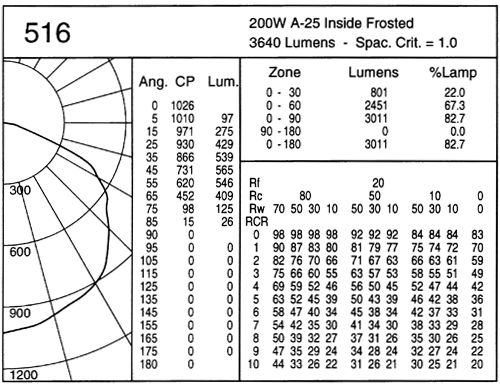Selecting the Right Architectural Lighting Fixture for Any Project Space
The Candela Distribution Curve
The candela distribution curve graphically illustrates the lighting distribution pattern of the fixture. This circular (or semi-circular) graph places the light source at the center and maps the various light intensities (in candelas) in incremental steps up the vertical plane (0-180 degrees) for a single horizontal viewing angle. The plots for multiple horizontal viewing angles can be laid over one another onto one distribution curve to better illustrate changes in the direction and intensity of light output that a person would experience as they walked around the fixture from one horizontal viewing angle to another.
There are a few important characteristics about the lighting fixture and how the lighting fixture will perform in a space that are quickly revealed by referencing the candela distribution curve. It can be an easy way to compare the lighting distribution of multiple fixtures of interest. First, the distribution curve will illustrate if the fixture is direct (emits light only below the horizontal axis), indirect (emits light only above the horizontal axis), or direct/indirect (emits lights both above and below the horizontal access). The distribution curve also reveals if the fixture distributes light in a focused spotlight pattern or a wider flood pattern. A fixture with a focused and spot distribution will have a relatively narrow distribution curve with light remaining either above or below the light source in the center of the graph, whereas a medium or wide floodlight will have an increasingly wider distribution pattern.
The candela distribution curve can also expose potential performance issues that a fixture may have, such as disruptions in the distribution pattern or a propensity for glare creation. A smooth and rounded candela distribution curve indicates that the light fixture will produce a smooth light pattern, whereas striations in the distribution pattern indicate that the fixture may cause inconsistent illumination and streaking in the space. The candela distribution curve can also reveal if a fixture is likely to produce glare. Fixtures that emit high-intensity (300+ candelas) light in the vertical viewing angle range of 55 to 90 degrees are considered at higher risk for creating glare in a space.
It is important to note that each candela chart and candela distribution curve is generated to reflect the performance of a specific fixture and lamp combination. Making changes to the lamp, fixture, or aspects of the fixture can materially alter the candela chart and candela distribution curve of the fixture.
The data found on a candela chart can be entered into lighting design software for more detailed analysis of the lighting fixture’s distribution of light and potential performance issues. Many manufacturers make this information readily available for their specification-grade fixtures. These files are typically produced in the standard format created by the Illuminating Engineering Society (IES) and are often referred to as IES files.
 |
The candela distribution curve is the visual representation of the lighting intensity information captured in the candela chart. |
Here is the candela distribution curve for the architectural lighting fixture with the reflector whose candela chart was examined in the section above. The candela distribution curve is the visual representation of the lighting intensity information captured in the candela chart. The candela chart captured the measurements for one horizontal viewing angle and that single horizontal viewing angle is represented in this single distribution curve. The curve intersects the zero degree vertical viewing angle at 1026 candelas. The candela power for the fixture decreases at each subsequent viewing angle until it reaches zero candelas at the 90 degree viewing angle. The smooth, rounded curve indicates that the lighting fixture will produce a smooth lighting pattern free of gaps in illumination.









